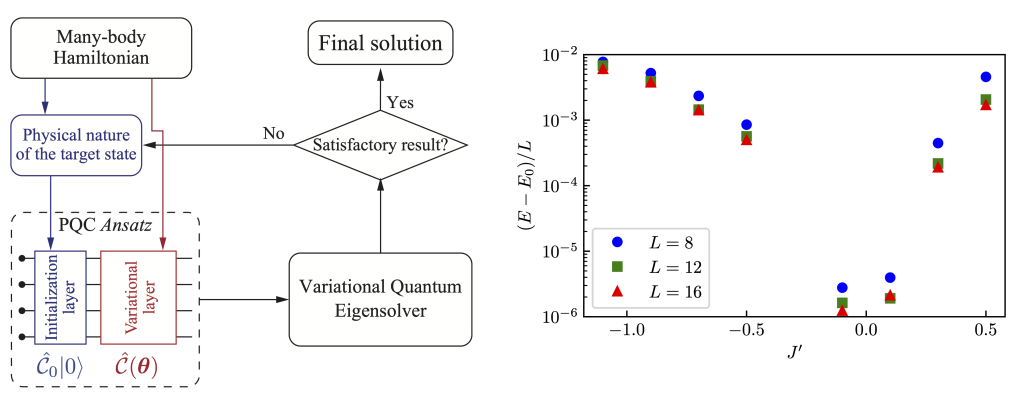Efficient variational quantum circuit structure for correlated topological phases
Posted On 2023.08.11

We propose an efficient circuit structure of variational quantum circuit Ansätze used for the variational quantum eigensolver (VQE) algorithm in calculating gapped topological phases on the currently feasible noisy intermediate-scale quantum computers. An efficient circuit Ansatz should include two layers: the initialization layer and the variational layer (see the lower-left-dashed block in the left panel of the above figure). In the initialization layer, a fixed-depth circuit state with a compatible entanglement structure to the target topological phase is constructed. The circuit state is further adjusted subsequently to capture the details of the local correlations, which is dictated with the Hamiltonian, in the parametrized variational layer. For the VQE calculation scheme based on this Ansatz, see the left panel of the above figure.
Based on this strategy, we design a circuit Ansatz to investigate the symmetry-protected topological Haldane phase in a nonexactly solvable alternating spin-1/2 Heisenberg chain by VQE calculations. Using a shallow circuit state with only one-depth variational layer, we demonstrate that the VQE energy deviation (see the right panel of the above figure) does not increase with the system size, thus implying the scalability of this VQE calculation. Furthermore, main characterizations of the Haldane phase, including the long-ranged string order, the fourfold nearly degenerate ground states associated with four different localized edge-mode patterns for the system with open boundaries, and the twofold degeneracy of the entanglement spectrum, are all observed for the optimized circuit states both in numerical simulations and on real quantum computers. The details of this study have been published in the following paper.
Journal reference: Rong-Yang Sun, Tomonori Shirakawa, and Seiji Yunoki, “Efficient variational quantum circuit structure for correlated topological phases” Phys. Rev. B 108, 075127.
DOI: https://doi.org/10.1103/PhysRevB.108.075127

